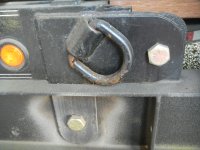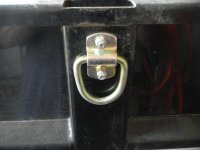Material thickness does enter into the decision. If there's sufficiently thick material, the bolts will have enough bearing area that they don't yield the sides of the hole. Good bolted joint design would also suggest that the part of the bolt that bears against the hole is a smooth shank; not threads. Other good design practices: as smooth a hole bore as you can manage - reamed, if you can. Also, hole size just a tad bigger than the bolt shank will reduce bearing stresses, too. And don't forget to put thick, flat washers between the nut and the hole! I have hooks bolted to my FEL and they have handled some good sized loads - I've maxed the 724kg loader lifting logs with them. I never apply a jerked load to them - at least not intentionally. They rely on static friction of the clamped joint to stay put up until the point they start to slide, then dynamic friction takes over, and it's much less helpful. Before you know it the clearance between the bolt and hole have disappeared and now the bolt and the metal on the sides of the hole start loading in shear and compression. That's when a smooth hole, smooth bolt shank and large contact area keep everything from going "DOINK".


